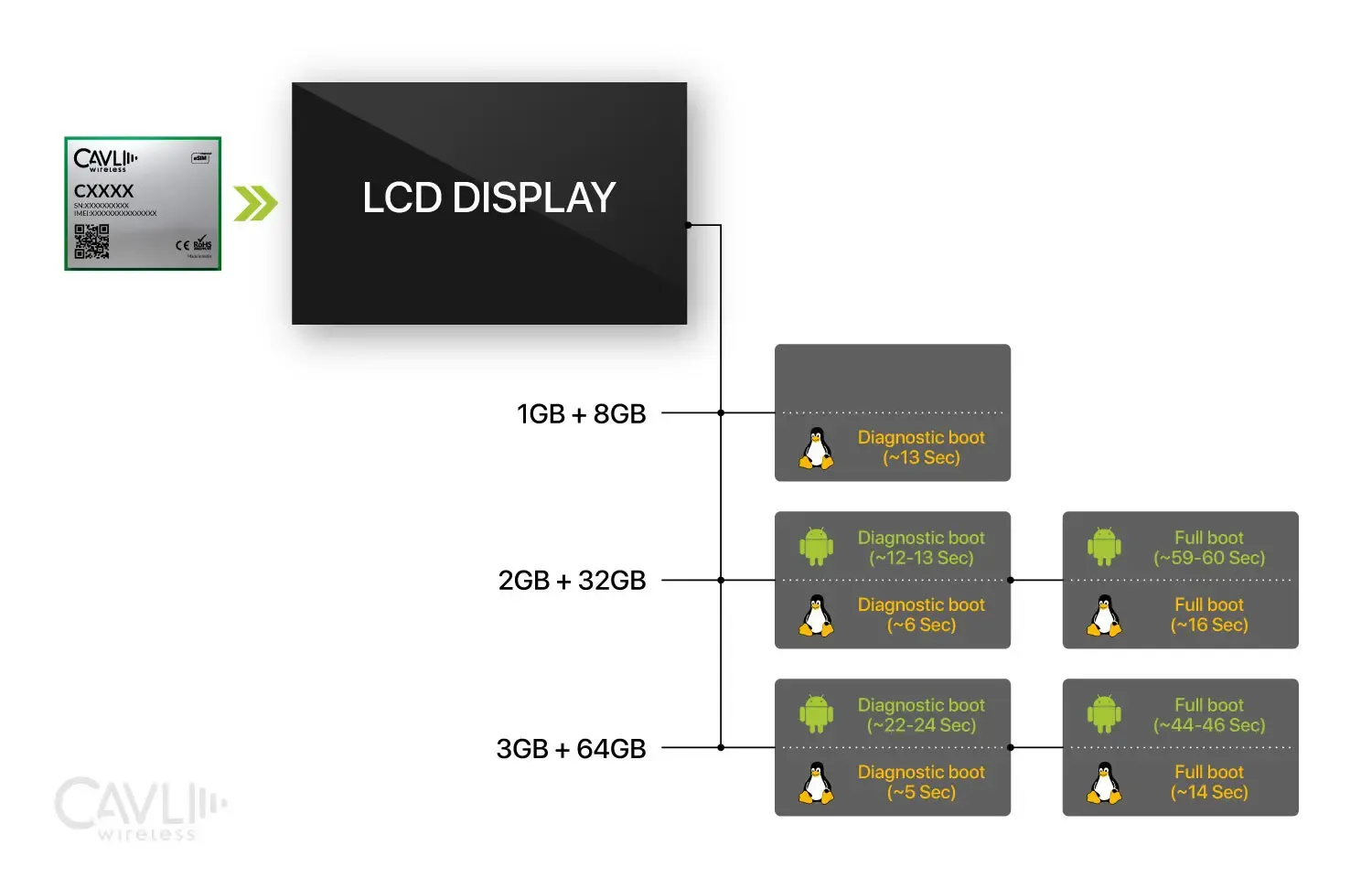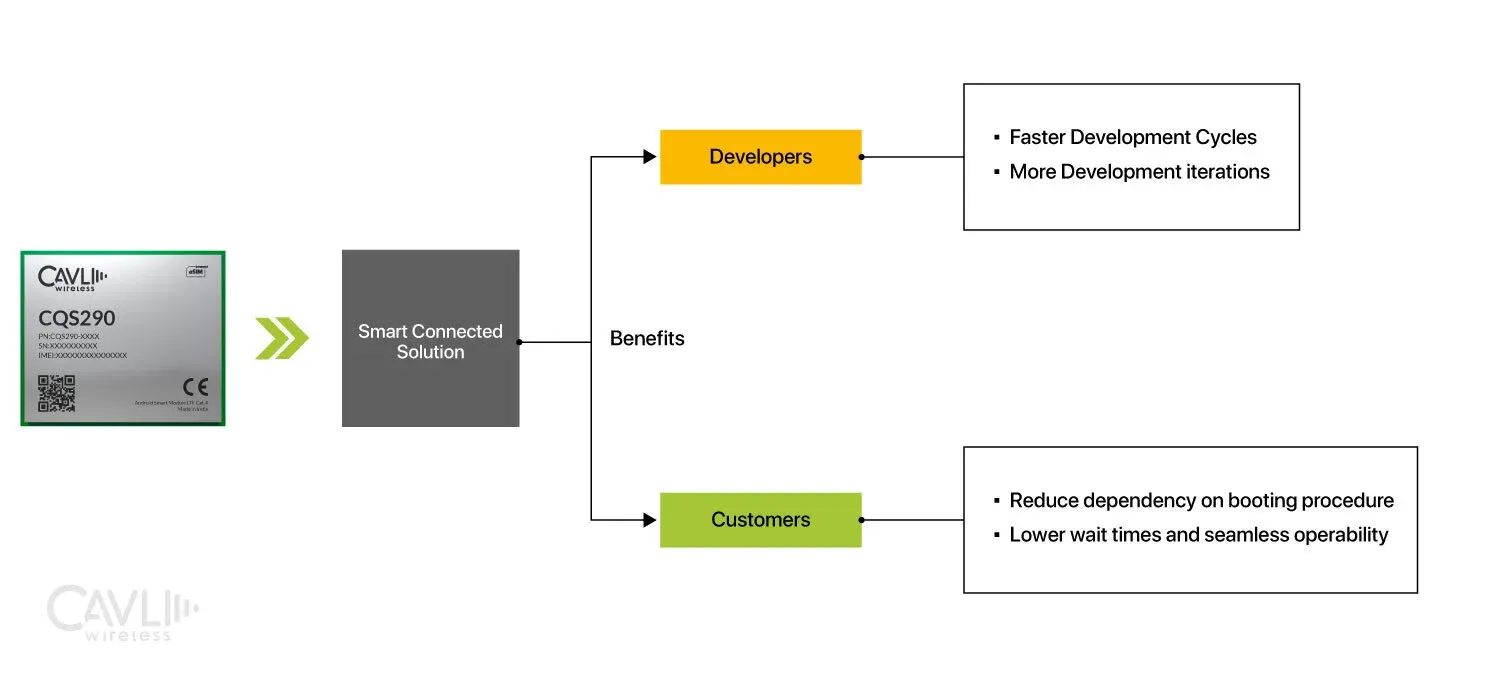In the fast-paced world of the Internet of Things (IoT), every second counts. For connected devices, rapid boot-up times are not just desirable—they are crucial for a seamless user experience and efficient operation. Delayed startup can lead to frustrated users, lost productivity, and even safety concerns in critical applications like smart kiosks or in-vehicle systems. Optimizing boot performance, however, can be a significant challenge for OEMs, often constrained by the limitations of embedded operating systems and available hardware resources. Cavli tackles this challenge head-on with the CQS29X Smart Module Series, offering a flexible combination of operating systems and memory configurations, meticulously tested and optimized for near-instantaneous deployments.
One of the primary hurdles OEMs face is selecting the right operating system for their connected solutions. The OS choice fundamentally impacts the device's boot-up time, responsiveness, security, and the overall development process. The CQS29X series offers a choice between Android and Linux, each with its own set of advantages and trade-offs:
How Do Android and Linux Compare for IoT Boot Performance?
Choosing between Android and Linux for IoT devices involves weighing factors like user interface, application ecosystem, and boot time. Below is a detailed comparison to help OEMs make informed decisions:
| Feature | Android (V12, SP up to 14) | Linux (V1.1.0) |
|---|---|---|
| User Interface | Rich graphical UI, familiar to consumers | Command-line or customizable UI, flexible for embedded systems |
| Application Ecosystem | Access to a vast app ecosystem via Google Play Store | Requires custom application development |
| Development | Easier application development with Java/Kotlin, rich APIs | Requires specialized C/C++ development skills |
| Resource Needs | Higher memory and processing power demands | Lower memory and processing power requirements |
| Boot Time | Generally longer due to OS complexity and application loading | Generally shorter due to leaner system profile |
| File System | Typically ext4 or f2fs | Highly customizable (ext4, f2fs, squashfs, etc.) |
| Power Management | More complex power management features | Simpler power management, potentially greater efficiency |
What Makes the CQS29X Ideal for IoT Applications?
The CQS29X series, comprising the CQS290, CQS291, and CQS292 modules, leverages the robust Qualcomm QCM2290/QWM2290 chipsets, providing reliable LTE Cat 4 and 2G connectivity. These modules boast a quad-core Arm Cortex A53 processor running at up to 2 GHz, ensuring ample processing power for even the most demanding applications. Crucially, the series offers a range of memory configurations tailored to diverse needs:
- 1GB LPDDR4X RAM + 8GB eMMC Flash: Optimized for cost-sensitive applications like sensor nodes, data loggers, or basic tracking devices, with faster boot times and lower power consumption.
- 2GB LPDDR4X RAM + 32GB eMMC Flash: A balanced option for complex applications like industrial gateways, asset trackers, and edge computing devices.
- 3GB LPDDR4X RAM + 64GB eMMC Flash: High-performance configuration for demanding applications like digital signage, in-vehicle infotainment, and industrial controllers.
How Does Cavli Optimize Boot Times Across CQS29X Configurations?
Cavli has invested significant effort in optimizing boot times across all OS and memory configurations of the CQS29X series. To understand the results, let’s explore key boot-related terms:
- Diagnostic/Display Boot: A minimal boot condition where essential functions, interfaces, and peripherals are operational, ideal for diagnostics and display functionality.
- Full Boot: Completion of all boot processes, enabling full system functionality and access to all features.

The results of this extensive optimization process are clear:
- 1GB + 8GB (Linux): ~13 seconds (Diagnostic boot) – Ideal for resource-constrained applications where rapid startup is paramount.
- 2GB + 32GB (Linux): ~6 seconds (Diagnostic boot), ~16 seconds (Full boot) – Offers significant improvement for applications requiring full system boot.
- 2GB + 32GB (Android): ~12-13 seconds (Diagnostic boot), ~59-60 seconds (Full boot) – Competitive for Android-based IoT applications.
- 3GB + 64GB (Linux): ~5 seconds (Diagnostic/Display boot), ~14 seconds (Full boot) – Fastest configuration for Linux-based systems.
- 3GB + 64GB (Android): ~22-24 seconds (Diagnostic boot), ~45-46 seconds (Full boot) – Optimized for complex Android applications.
Why Do OEMs Benefit from CQS29X’s Fast Boot Times?
For engineers developing IoT solutions like smart vending machines, rapid boot times are critical for efficient development cycles. With the CQS290, firmware updates and testing are completed in seconds, enabling faster iterations and meeting tight deadlines. This efficiency translates to cost savings and superior product performance.
In real-world scenarios, such as a smart kiosk at a busy airport, the CQS290 ensures near-instantaneous startup, reducing wait times and enhancing user satisfaction. Similarly, in industrial settings, fast boot times improve operational efficiency for devices like asset trackers or edge computing systems.

How Does CQS29X Enhance End-User Experience?
For end-users, fast boot times translate to seamless operability. In a smart connected EV two-wheeler powered by the CQS291, the Diagnostic/Display boot ensures quick access to navigation or entertainment features, even if the full Android boot takes about a minute.
In retail, a point-of-sale system powered by the CQS29X recovers quickly after a power outage, minimizing disruptions and keeping lines moving. For safety-critical applications, like a car’s 360-degree camera system powered by the CQS292, instant boot times ensure immediate visibility when reversing, enhancing driver safety.
Why Choose CQS29X for Your IoT Project?
The CQS29X series demonstrates Cavli’s commitment to high-performance, flexible, and developer-friendly IoT solutions. By offering optimized boot times, versatile memory configurations, and seamless integration with the Cavli Hubble IoT management platform, Cavli empowers OEMs to create cutting-edge devices for a connected world. Contact Cavli today to learn how the CQS29X can accelerate your next IoT project and bring your vision to life.
Go Beyond and Explore
What are the key factors contributing to the CQS29X series’ optimized boot times?
The CQS29X series achieves superior boot times through meticulous engineering optimizations at both the hardware and software levels. These include:
- Efficient memory configurations (1GB, 2GB, 3GB LPDDR4X RAM) and storage options (8GB, 32GB, 64GB eMMC) that reduce initialization delays.
- Customized OS-level optimizations tailored for Android and Linux, streamlining system services for faster Diagnostic and Full boot modes.
- Advanced bootloader enhancements leveraging Qualcomm QCM2290/QWM2290 chipsets to minimize latency during system initialization.
How does the choice between Android and Linux impact device boot-up performance on the CQS29X series?
The operating system plays a pivotal role in determining boot-up efficiency:
- Linux: Offers faster Diagnostic and Full boot times (as low as 5 seconds for Diagnostic and 14 seconds for Full boot) due to its lightweight kernel and minimal overhead. Ideal for resource-constrained or real-time applications.
- Android: While inherently slower due to its complex framework, optimizations on the CQS29X series achieve reasonable boot times (~22–24 seconds for Diagnostic, ~45–60 seconds for Full boot), making it suitable for multimedia-rich or interactive applications.
What engineering considerations should be taken into account when selecting a CQS29X configuration?
Engineers must evaluate application-specific requirements against the series' configurations:
- 1GB LPDDR4X + 8GB eMMC: Best for cost-sensitive projects like basic sensor nodes and data loggers where boot time and power efficiency are critical.
- 2GB LPDDR4X + 32GB eMMC: Balances performance and cost, catering to industrial IoT gateways and edge computing devices.
- 3GB LPDDR4X + 64GB eMMC: Designed for demanding applications requiring high-speed data processing, complex user interfaces, or rich multimedia.
What diagnostics and boot modes are available for system testing and deployment with the CQS29X series?
The CQS29X series supports two distinct boot modes:
- Diagnostic/Display Boot: Activates essential system functionalities and interfaces within 5–24 seconds, depending on the configuration. Ideal for quick diagnostics, testing, and partial system readiness.
- Full Boot: Ensures complete system initialization, including all services and features, with boot times ranging from 14 seconds (Linux) to 60 seconds (Android). This mode is critical for applications requiring full functionality and operational readiness.

